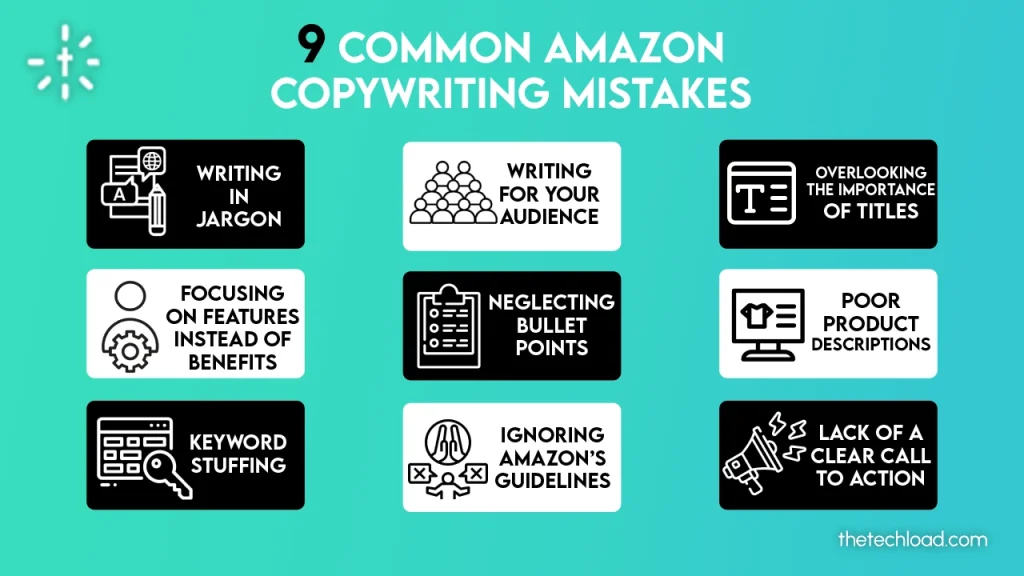Writing copy for your Amazon product listings can make or break your sales. Many sellers unknowingly make common Amazon Copywriting mistakes that hurt their visibility and ranking, costing them potential customers. These errors, like keyword stuffing or poorly structured bullet points, can reduce trust and deter buyers.
The good news is that these mistakes can be easily fixed with the right approach. By understanding how to avoid these pitfalls, you can create listings that attract more clicks and convert those clicks into sales.
Want to know how to avoid these common missteps? Read on to discover the nine most common Amazon copywriting mistakes and how to fix them!
Common Amazon Copywriting Mistakes – Quick Overview

Here’s a quick overview of the nine most common Amazon copywriting mistakes.
- Writing in Jargon
- Not Using a Conversational Tone or Writing for Your Audience
- Overlooking the Importance of Titles
- Focusing on Features Instead of Benefits
- Neglecting Bullet Points
- Poor Product Descriptions
- Keyword Stuffing
- Ignoring Amazon’s Guidelines
- Lack of a Clear Call to Action
9 Common Amazon Copywriting Mistakes and How to Fix Them for Better Results
Here’s an in-depth look at the 9 most common Amazon copywriting mistakes and straightforward solutions to enhance your product listings and drive more sales.
1. Writing in Jargon
One of the most common mistakes in Amazon copywriting is using industry-specific jargon or buzzwords. These terms might make sense to you, but they can confuse or alienate potential customers who don’t understand the language. You risk losing your audience’s attention if your listing is filled with technical terms or trendy phrases.
Instead, focus on writing in clear, simple language that anyone can understand. Your goal is to make the product accessible to all potential buyers, regardless of their knowledge level. Avoiding jargon and keeping the language straightforward makes it easier for customers to engage with and understand your product.
2. Not Using a Conversational Tone
Another frequent mistake is failing to match your tone of voice to your audience. If your tone is too formal or stiff, you might miss connecting with your target customers. Amazon shoppers respond better to friendly and conversational listings, making the product seem approachable.
To fix this, you need to think about who your ideal buyer is. If your target audience is young and trendy, your writing should reflect that. On the other hand, if you’re selling to an older, professional crowd, a more polished and straightforward tone might be necessary. The key is to adapt your tone to resonate with the people you’re trying to reach.
3. Overlooking the Importance of Titles
The product title is one of the most crucial elements of your Amazon listing. Many sellers make the mistake of writing vague or generic titles that don’t provide enough information. A title like “Travel Bag” is too broad and won’t stand out in a sea of similar listings.
A well-crafted title should include important details like the product name, key features, and benefits. For example, “Durable Chest Travel Bag with Anti-Theft Features – Black” is more descriptive and likely to grab a shopper’s attention. A clear, keyword-rich title improves your product’s visibility and click-through rate.
4. Focusing on Features Instead of Benefits
Another common mistake is listing product features without explaining their benefits. While features tell shoppers what a product can do, they don’t always explain why those features matter. Shoppers want to know how your product will solve their problems or make their lives easier.
The fix is simple: always pair features with benefits. If your product is waterproof, explain how it will dry their belongings in any weather. By highlighting the real-world advantages of your product, you’ll make it more appealing and increase the chances of a sale.
5. Neglecting Bullet Points
Many sellers need to pay more attention to the power of bullet points in their listings. Bullet points are essential because they allow customers to scan the most important information about your product quickly. You risk overwhelming potential buyers if your product description is just a long text block.
Break down key features and benefits into easy-to-read bullet points to fix this. Focus on important details like size, material, and special features. Bullet points help communicate essential information quickly, making the difference in whether a customer stays on your listing or moves on.
6. Poor Product Descriptions
A weak or poorly written product description can turn customers away. Many sellers make their descriptions too short and vague or too long and complicated. Both can hurt your chances of making a sale because shoppers won’t get the information they need.
To fix this, ensure your product description strikes a balance. It should provide all necessary details while remaining easy to follow and engaging. Focus on telling a story about how the product is used and clearly explain its features and benefits in an informative and appealing way.
Want to know more about creating effective product descriptions? Learn what an Amazon product description writer does to get expert tips on crafting compelling content that boosts your sales.
7. Keyword Stuffing
Keyword stuffing happens when sellers try to fit too many keywords into their product titles, descriptions, or bullet points. While keywords are important for making your product easier to find on Amazon, using too many can make your listing easier to read and clear. This can turn away potential customers, and Amazon may even lower your ranking for poor content quality.
Use keywords naturally in your title and description to fix this so the text flows smoothly. You can also take advantage of Amazon’s “backend keywords” section. These hidden keywords help with search rankings but aren’t visible to customers. This way, you can improve your visibility without making the main listing feel cluttered or awkward.
8. Ignoring Amazon’s Guidelines
Ignoring Amazon’s guidelines can seriously hurt your product listing. Amazon has specific rules about what you can and cannot include in your product descriptions and titles. For example, using banned phrases like “best,” “cheapest,” or “guaranteed” can lead to your listing being flagged or removed. These terms are often prohibited because they can be misleading or unsubstantiated.
Additionally, certain triggered phrases, such as claims of medical benefits or unauthorized brand names, can get your listing into trouble. It’s important to review Amazon’s guidelines carefully and avoid misleading or inappropriate language. By adhering to these rules, you avoid penalties and ensure that your listing remains active and compliant, which helps build trust with potential buyers.
9. Lack of a Clear Call to Action
A common oversight in Amazon copywriting is not including a clear call to action (CTA). Without a direct invitation to buy or take the next step, shoppers may leave your listing without purchasing, even if they’re interested.
End your product descriptions and bullet points with a strong CTA to fix this. Phrases like “Add to Cart Now” or “Order Today for Fast Delivery” can motivate buyers to take action immediately. A clear and compelling CTA increases the chances of converting a browser into a buyer.
Amazon Copywriting Mistakes: Conclusion
Avoiding common Amazon copywriting mistakes is essential for creating effective product listings that stand out and drive sales. From steering clear of keyword stuffing and jargon to following Amazon’s guidelines and using clear, engaging language, every detail matters. Addressing these issues can enhance your listing’s readability, improve search rankings, and attract more customers.
If you’re looking to optimize your Amazon listings and avoid these pitfalls,The TechLoad is here to help. Our expertise in Amazon copywriting ensures that your product descriptions are compelling and compliant, boosting your visibility and conversions.
Contact The TechLoad today to transform your listings and achieve better results!
Amazon Copywriting Mistakes: FAQs
What is keyword stuffing in Amazon product listings?
Keyword stuffing is the practice of overloading your listing with excessive keywords, making the text hard to read and potentially lowering your search ranking.
Why are clear product descriptions important for Amazon listings?
Clear product descriptions help customers quickly understand the product’s benefits and features, leading to better engagement and higher conversion rates.
What are Amazon’s guidelines for product descriptions and titles?
Amazon’s guidelines prohibit misleading claims, excessive punctuation, and using prohibited terms. Ensure your content is accurate, concise, and follows Amazon’s formatting rules.
How can a call to action improve my Amazon listing’s performance?
A call to action guides potential buyers on what to do next, such as “Add to Cart” or “Buy Now,” increasing the likelihood of a purchase.
Why should I use bullet points in my Amazon product descriptions?
Bullet points make key information easy to scan and digest, helping customers see important features and benefits quickly.
What are the best practices for writing effective product titles on Amazon?
Effective titles should be clear, descriptive, and include relevant keywords. They should also provide essential details like product type, key features, size, etc.





